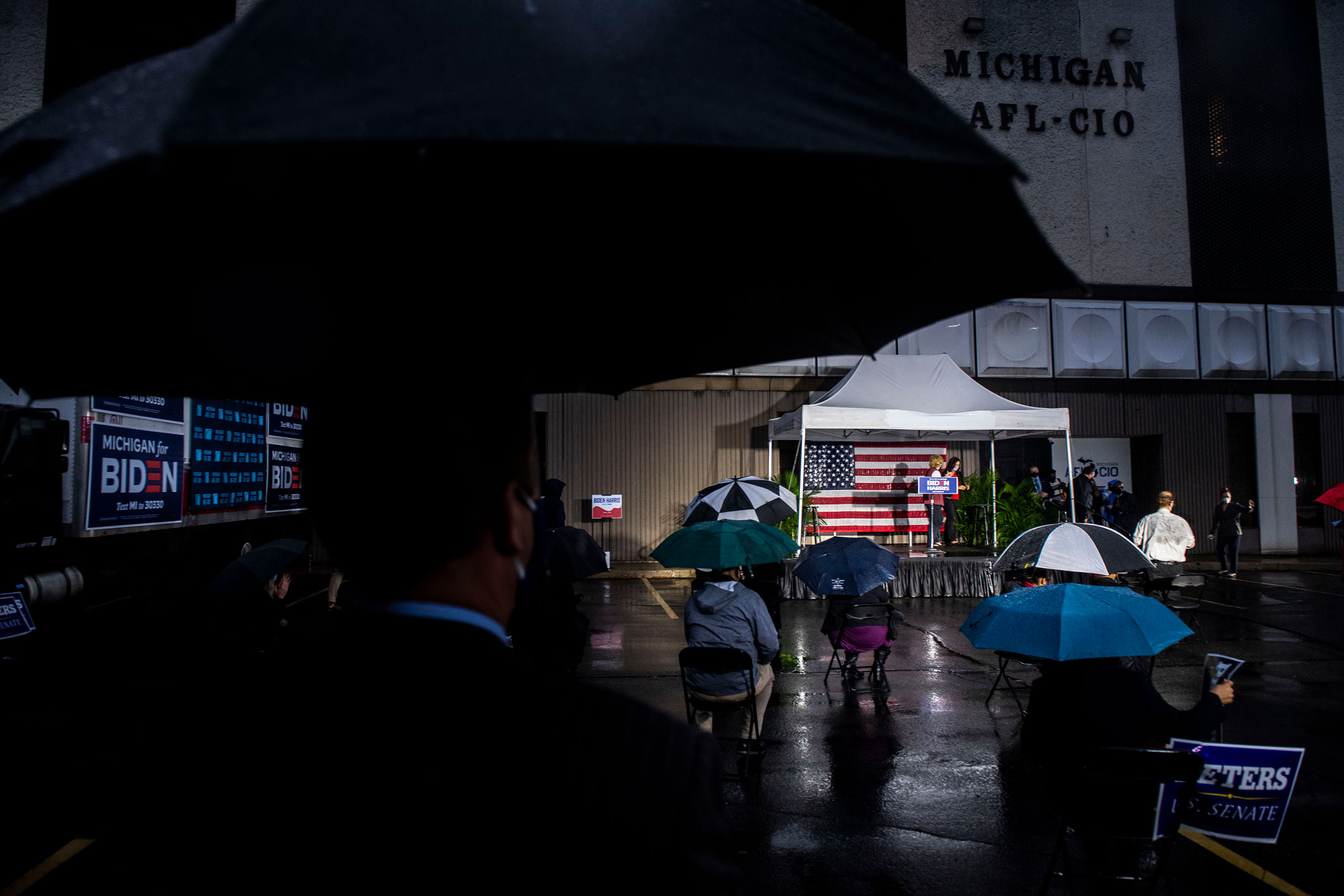
This article is part of the The DC Brief, TIME’s politics newsletter. Sign up here to get stories like this sent to your inbox every weekday.
Trump spent most of 2016 in a one-way fight with Detroit’s automakers. He hammered them for moving jobs to Mexico and for shuttering iconic factories that were long linked to Detroit’s core identity. He promised in user-friendly sound bites to bring back the jobs. Michiganders rewarded him, giving Republicans a slim win in the state for the first time since George H.W. Bush carried it in 1988.
Four years later, Michigan’s economy has, quite simply, not seen the promised benefits of a Trump presidency. Despite Trump’s rhetoric that America’s Black voters had nothing to lose by backing him, racial disparity in the state is still staggeringly deep. At 15%, Michigan has the highest poverty rate of the five Midwest swing states still in play. Blacks are six times more likely than whites to live in economically distressed areas in this state.
Among the 12 Michigan counties that went from supporting Barack Obama in 2012 to Trump in 2016, these disparities are getting worse by a two-to-one margin, according to one study out just this week. And that was before the coronavirus pandemic sent the state’s unemployment rate from 3.6% in February to 24% in April, according to the Bureau of Labor Statistics, in a state where Trump had his narrowest win in 2016.
As The D.C. Brief makes its way to Michigan today, the economic woes of the industrial Midwest come into sharp focus. Michigan’s manufacturing legacy is still a point of pride for the state’s residents and a source of near-nostalgia for voters who remember when General Motors’ 2.1-million-square foot plant in Warren provided a lifetime gig with tremendous benefits. It shut its doors last year, one of five GM facilities to do so in that round of bloodletting.
The mothballed plant sits in the southern stretch of Macomb County, one of the 12 counties that flipped from blue to red four years ago. During the primary in 2016, Trump visited Warren for a boisterous rally, promising harsh tariffs for automakers taking parts of their business abroad. “You’re going to pay a 35% tax every time you ship a car, truck or part into the United States,” Trump said during a visit to a community college just a 10-minute drive from the then-open Warren plant. The conversations that I had with voters outside that rally led me to think the message was working — and they were. He handily won the state’s primary a few days later. He’d repeat the victory eight months later against Clinton.
Today, Trump is heading to nearby Oakland County, where Clinton won by 8 percentage points, as did Obama in 2012. Voters there should brace for more rosy talk about a roaring economy and revitalized auto industry — despite Michigan having 4,700 fewer jobs in the auto industry than when Trump took office. That’s almost a 12% dip.
Michigan’s economy as a whole is in trouble, too. Sixteen percent of Michiganders live in economically depressed areas, outpacing every state in the region but Ohio, according to an analysis from the bipartisan Economic Innovation Group. The urban-rural divide remains stark, with residents outside of cities faring better.
Michigan voters in 2008 and 2016 alike voted for candidates preaching change, and it appears they may be ready to once again turn a page. Polling in the state shows Biden with a consistent leg up. Of the 60 surveys included in Real Clear Politics’ polling universe, Trump has led in just four, and they’re all from the same Republican-leaning pollster. At this point, Biden’s advantage in Michigan — up 6.5 percentage points — is roughly twice as strong as Clinton’s final polling standing before she lost the state by less than 11,000 votes.
Biden’s team is feeling confident about the state, but leaving nothing to chance. The former VP and his outside allies have outspent Team Trump almost five-fold during this campaign on television alone in Michigan, though overall, the state has seen less than half of the spending being unleashed on Florida, according to NPR’s analysis of ad spending. A review of Kantar/CMAG data accessed through the Wesleyan Media Project shows Biden’s side has aired almost 12,000 more ads than Trump since Oct. 12. In all, Michigan voters have seen more than 22,000 ads in the last three weeks.
And while Democrats are enjoying about a 4-percentage-point advantage in early-voting returns at the moment, the state — lousy economy and all — isn’t necessarily in the bag for Biden. The New York Times/ Siena College poll of Michigan, released this week, shows 69% of Michigan Republicans plan to vote in-person on Election Day, while 28% of Democrats said the same. John James, the GOP’s Senate nominee, is a 39-year-old charismatic Black Army veteran who is giving some tailwinds behind the entire Republican ticket.
And Trump has been here before — and he is his best closing pitchman. It will just require Michigan voters to once again believe the President can solve the state’s legacy economy with bluster and nostalgia.
Make sense of what matters in Washington. Sign up for the daily D.C. Brief newsletter.
More Must-Reads from TIME
- Cybersecurity Experts Are Sounding the Alarm on DOGE
- Meet the 2025 Women of the Year
- The Harsh Truth About Disability Inclusion
- Why Do More Young Adults Have Cancer?
- Colman Domingo Leads With Radical Love
- How to Get Better at Doing Things Alone
- Michelle Zauner Stares Down the Darkness
Write to Philip Elliott at philip.elliott@time.com